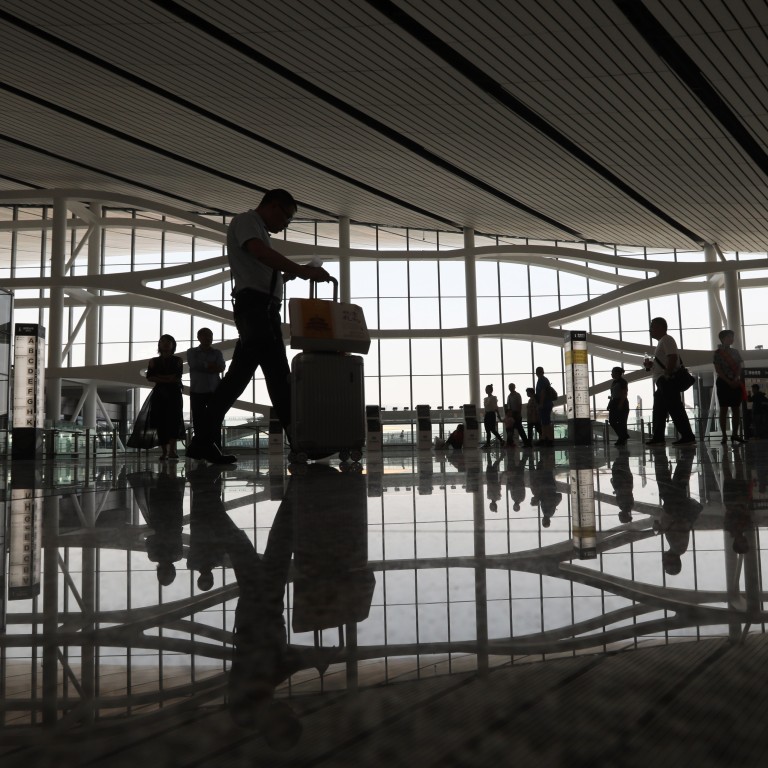
Global travel demand to and from mainland China recovering at strong pace, IATA chief says, but analysts cautious amid economic slowdown, geopolitical rifts
- International Air Transport Association chief Willie Walsh says industry body is predicting mainland’s international travel demand will recover next year
- ‘The pace of recovery since the market reopened earlier this year has been quite strong, so I think that is the reason we are optimistic about it going forward,’ he adds
Global travel demand to and from mainland China is recovering at a “strong” pace, an international airline association head has said, but analysts have warned that the country’s economic slowdown and geopolitical tensions could hinder a return to pre-pandemic levels next year.
International Air Transport Association (IATA) director general Willie Walsh also told the Post the trade lobby had predicted that the mainland’s international travel demand would recover next year.
“The pace of recovery since the market reopened earlier this year has been quite strong, so I think that is the reason we are optimistic about it going forward,” he said last week while on the sidelines of a media event at the association’s headquarters in Geneva.

According to the association, international travel demand to and from the mainland remained 40 per cent below pre-pandemic levels.
The mainland accounted for 9 per cent of all international air passenger demand before the Covid-19 pandemic in early 2020, it said.
Figures from consultant McKinsey showed mainland travellers made more than 150 million international trips in 2019, spending about US$1 trillion.
International travel to and from the mainland ground to a halt for about three years under Beijing’s stringent coronavirus curbs, before authorities lifted restrictions in January and resumed issuing tourist visas from March.
The revival of the mainland’s international flight capacity from unprecedented lows is is taking time.
Recovery of Hong Kong aviation sector ‘stronger than expected’: IATA chief
At the same time, difficulties securing visas, strong demand for domestic flights and weaker economic growth weighing on recovery efforts have hamstrung demand for international flights.
Aviation analytics firm Cirium noted that scheduled seat capacity on international flights to and from the mainland last month was 38 per cent lower than the level recorded for December 2019.
But domestic seat capacity in December was almost 12.5 per cent higher than levels recorded for the same month in 2019.
The slower-than-expected rebound for travel from the mainland is also expected to affect the full recovery of airlines in the Asia-Pacific region.

At a meeting of 14 members of the Association of Asia-Pacific Airlines in November, Japan Airlines and Thai Airways representatives told the Post they were shifting capacity away from the mainland, where travel demand was weak, and directing resources towards markets such as Hong Kong and Europe.
Thailand had previously banked on a resurgence of mainland tourists to support its economy, later revising estimates that it would welcome 5 million visitors by year’s end from its regional neighbour and cutting the figure down to about 3.5 million.
IATA chief economist Marie Owens Thomsen said there was cause for optimism after Chinese President Xi Jinping and his US counterpart Joe Biden agreed last month to increase direct flights between the two countries.
She said the push to increase flights between the two countries was essential in bringing the mainland’s international traffic back up to pre-pandemic levels, which had been hampered amid a period of growing geopolitical tensions.
Recovery of Hong Kong aviation sector ‘stronger than expected’: IATA chief
The number of flights between the US and the mainland currently stands at about 70 per week, compared with more than 300 each week in 2019.
But Owens Thomsen said the association’s forecast could be upended by factors such as a decline in Chinese trade, high youth unemployment and the “fragility” of the local property sector.
The latter recently came under the spotlight as big developers on the mainland struggled to pay off debts and owners raised concerns over unfinished properties.

Discussing the potential risks on the horizon, the association’s chief economist said she believed they would not “dominate” the situation and that international demand would still rise to 2019 levels in the first half of 2024.
“If the economy slows, demand is more than likely to slow, but it still looks like people are increasingly regarding travel as a necessity, and will still allocate budget to that,” she said.
Dr Xie Xingquan, IATA’s regional vice-president for North Asia, said perceptions about the safety and security of some international destinations were also having an effect on demand for flights from the mainland.
He also voiced approval for the decision by authorities on the mainland to grant visa free travel for one year to French, German, Dutch, Spanish, Italian and Malaysia passport holders.
“We hope the government will consider expanding the list, which will help facilitate international travel to China,” Xie said.
Asia Aviation Valuation Advisors chairman David Yu said there was pent-up demand for leisure and business travel to and from the mainland, but a lack of aircraft supply and backed up order books among manufacturers Boeing and Airbus were continuing to have a damping effect on international flight capacity.
Airlines pivot to Hong Kong, other markets amid sluggish mainland travel demand
Other elements included a lack of available older aircraft, economic factors and the closure of Russian airspace amid tensions over the country’s invasion of Ukraine in 2022.
The war prompted Western countries to impose flight bans on Russia, while Moscow retaliated by closing off its airspace to nations it considered hostile.
Some European and United States carriers warned that the situation had created an uneven playing field as Chinese, Gulf state and Indian carriers still enjoyed access to the country’s airspace and could avoid making costly detours.
“From a bilateral standpoint, the US and Europe are not going to let the Chinese carriers fly over Russia, because it is going to make their own carriers not competitive,” he said.
“You have a choice of flying two or three extra hours or not, at similar prices? It’s a pretty easy equation.”
Sky-high air fares new normal for Hong Kong and rest of world: top Cathay executive
Yu also compared carrier China Eastern’s decision to reinstate flights between Shanghai and New York, while United Airlines had yet to make a similar move.
But industry leaders have described the lack of flights between the mainland and the US as a boon for Hong Kong flag carrier Cathay Pacific Airways, with travellers from over the border using the city as a gateway to America.
Yu said he agreed with a HSBC report from November 24 that warned Cathay Pacific’s long-haul traffic could be affected by a resumption of direct flights between the mainland and the US.
Touching on the future prospects of the mainland’s international travel demand, he said: “It is going to recover, but it is going to be slower than what they think. Next year? Doubtful from my perspective. I am looking at 2025 for recovery.”

